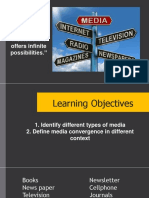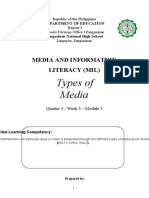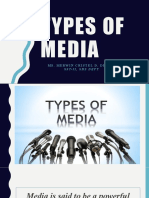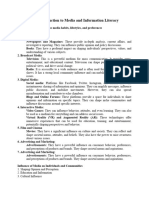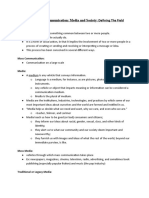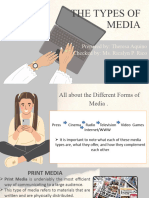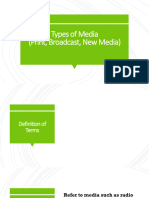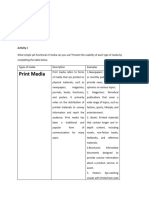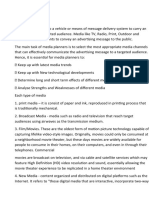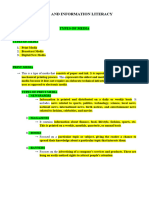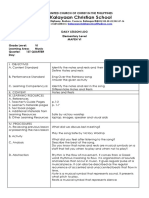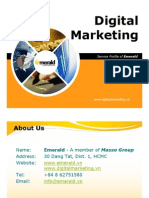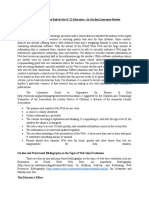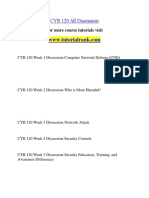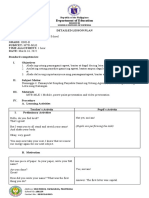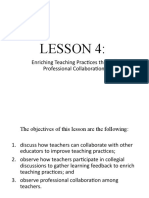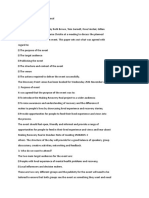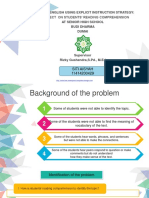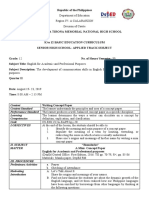Media and Information Literacy
MODULE 4: TYPES OF MEDIA
MEDIA 4 TYPES OF MEDIA
● a source of credible and current 1. Print Media
information created through an 2. Broadcast Media
editorial process determined by 3. Film/Cinema
journalistic values whereby editorial 4. New Media
accountability can be attributed to a
specific organization or a legal person 1. PRINT MEDIA
● It is a written or pictorial form of mass ● the more traditional platforms of
communication and is mechanically or communication that are tangible and
electronically generated by impression have undergone printing.
or photocopying. ● a form of mass communication strategy
● Is a kind of mass communication that that uses hard copy printed mediums
creates and disseminates news and like newspapers, direct mail, banners,
information through printed billboards, and magazines to reach
publications. consumers.
● simply refers to a vehicle or means of ● The advertising industry identifies print
message delivery system to carry an ad media as one of the oldest mediums
message to a targeted audience. used to promote products.
● a vehicle or means of message delivery
8 ROLES OF MEDIA system to carry an ad message to a
1. Act as a channel of information and targeted audience.
knowledge through which citizens
communicate with each other and EXAMPLES:
make informed decision ● Books
2. Facilitate informed debate between ● Newspapers
diverse social actors ● Magazines
3. Provide us with much of what we learn ● Journals
about the world beyond our immediate ● Pamphlets
experience ● brochures
4. Are means by which a society learn ● other reading materials
about itself and build a sense of
community
7 TYPES OF ADVERTISEMENTS UNDER PRINT
5. Function as a watchdog of government
in all its forms, promoting transparency MEDIA
in public life and public scrutiny of
those with power through exposing 1. Newspaper Advertising
corruption, maladministration and 2. Magazine Advertising
corporate wrong-doing 3. Direct-Mail Advertising
6. Are essential facilitators of democratic 4. Directory Advertising
processes and one of the guarantors of 5. Outdoor Advertising
free and fair elections 6. Transit Advertising
7. Are a vehicle for cultural expression and 7. Specialty Advertising
cultural cohesion within and between
nations
8. Function as an advocate and social
actor in its own right while respecting
pluralistic values.
1
�1. NEWSPAPER ADVERTISING 5. OUTDOOR ADVERTISING
Advantages: ● Standardized signs are available to
● Large readership and a high level of local, regional, or national advertisers.
reader involvement ● Purchased from outdoor advertising
● Advertisers can target certain people companies in standard sizes
● The cost is relatively low ● Are placed in highly traveled roads, and
● Ads are timely freeways where there is high visibility.
Disadvantages: POSTERS
● Short life pre-printed sheets put up like wallpaper on
● Black and white (although many papers outdoor billboards.
are changing to color format)
PAINTED BULLETINS
2. MAGAZINE ADVERTISING
painted billboards that are changed about
Advantages: every six months to a year.
● Can target audiences
● Longer life span SPECTACULARS
● Print quality is good
use lights or moving parts and are in high traffic
● People keep magazines longer than
areas.
newspapers
● Offer a variety of presentation formats
Advantages:
● Highly visible and relatively inexpensive
Disadvantages:
24-hour a day message and located to
● Less mass appeal within a geographical
reach specific target markets
area
● More expensive
Disadvantages:
● Deadlines make them less timely
● Becoming more restricted-Increasingly
regulated
3. DIRECT-MAIL ADVERTISING ● Limited viewing time
Advantages:
● Can be highly selective 6. TRANSIT ADVERTISING
● Controlled timing
Uses public transportation facilities Commuter
● Can be used to actually make the sale
trains, taxis and buses, station posters near or
in subways and in railroad bus, and airline
Disadvantages:
terminals.
● Low response level
● People think of it as “junk mail”
Advantages:
● Cost is high
● Reaches a wide captive audience
● Economical
4. DIRECTORY ADVERTISING ● Defined market
Advantages:
● Relatively inexpensive Disadvantages:
● Can be used with all demographic ● Not available in smaller towns and cities
groups ● Subject to defacement
● Are found in most of the households
● Usually kept for at least a year 7. SPECIALTY ADVERTISING
● Relatively inexpensive, useful items
Disadvantage:
with an advertisers name printed on
● Only printed once a year
them
● Some service businesses are used
● Given away with no obligation attached
infrequently; Therefore, directory
● Calendars, magnets, pens, pencils,
advertising must be combined with
memo pads, and key chains
another type.
2
� 2. BROADCAST MEDIA 3. FILM/CINEMA
● The broadcast media like radio and ● A form of entertainment that enacts a
television reaches a wider audience as story by sound and a sequence of
opposed to the print media. images giving the illusion of continuous
● The term broadcasting refers to the movement.
airborne transmission of electronic ● Also known as a “movie” or a “motion
audio signals (radio) or audiovisual picture,” is a series of moving images
signals (television) that are readily shown on a screen, usually with sound,
accessible to a wide population via that make up a story.
standard receivers. ● also known as motion picture
● Are the communication platforms
described through its capability of 4. NEW MEDIA
distributing audio and video content to ● Digital media that are interactive
a wide array of audience. ● incorporate two-way communication
● involve some form of computing
2 TYPES OF ADVERTISEMENTS UNDER
BROADCASTING MEDIA
1. TELEVISION ADVERTISING
Advantages:
● Can be directed to an audience with a
specific interest.
● Messages can be adapted to take
advantage of holidays and special
events.
Disadvantages:
● Highest production cost of any media
type.
● High dollar cost for the time used.
● Actual audience size is not assured –
people leave the room or channel surf –
effect of TIVO
2. RADIO ADVERTISING
Advantages:
● Can select an audience, such as teens
by choosing the right station
● More flexible than print – messages
can be easily changed
● It’s a mobile medium – can be taken
just about anywhere
Disadvantages:
● Short life span - when broadcast, it is
over
● Lack of visual involvement
3
� MEDIA CONVERGENCE ● technologies give people access to a
● the merging of previously distinct wide variety of media at all times and in
media technologies and platforms almost all places.
through digitization and computer
networking. PLURALISTIC VALUES
● also known as technological respecting one’s values and beliefs to avoid
convergence. conflict
● Process by which multiple media
technologies are brought together into ORIGIN OF MEDIA CONVERGENCE
one computerized device arose from the digitalization and rapid internet
● It has led to the creation of usage that fostered new forms of content while
smartphones that can perform the transforming industries, services, and practices.
functions of multiple devices like
cameras, phones, and music players.
● Media convergence has made it
4 TYPES OF MEDIA CONVERGENCE
possible for people to access various
forms of media on a single device.
● It has resulted in the development of 1. TECHNOLOGICAL CONVERGENCE
cross-media content that is provided in ● Merging technologies that allow access
different formats through portals and to previously inaccessible technologies
links. on one device, such as the iPhone.
● Media convergence has led to industrial ● The iPhone is an example of
mergers and media players diversifying technological convergence, as it
their products across various combines various media content that
platforms. was once tied to specific platforms.
● has led to the development of
EXAMPLES: cross-media content and the
● Smartphones transformation of various industries.
● Tablets ● It has caused a shift in media
● smart devices consumption from traditional platforms
to digital devices.
● has made it possible to access all sorts
IMPORTANCE OF MEDIA CONVERGENCE
of media within one digital device.
● It brings together the “three C’s”
(computing, communication, and
2. INDUSTRIAL CONVERGENCE
content)
● a direct consequence of the ● the merging of different industries,
digitization of media content and the often driven by media convergence.
popularization of the Internet. ● Giant media players like Time Warner
● Media convergence transforms have diversified their products across
established industries, services, and various platforms, including DC Comic
work practices and enables entirely Universe, HBO, CNN, Time magazine, and
new forms of the content to emerge. Warner Brothers Pictures.
● the merging of distinct technologies ● These media giants are present in every
into one, joining completely separate mass media platform, similar to Disney
ideas into one big idea. and Google.
● has led to the creation of cross-media
content and the transformation of
EFFECT ON SOCIETY
various industries.
● Media convergence has expands
● It has also led to increased competition
access to media,
and consolidation within the media
● But, it also allowed fake news to spread
industry.
IMPORTANCE OF TECHNOLOGY 3. SOCIAL CONVERGENCE
CONVERGENCE
● shift the media experience from
● The key element of media convergence passive consumption to active
4
� participation and user-created Potential developments include the ability to
content. upload thoughts in real time without physical
● It has led to the rise of user-created input.
content and the blurring of lines Questions remain regarding media policy and
between amateur and professional the replacement of smartphones.
content.
● increased transparency in media THE NEXT STEP IN MEDIA CONVERGENCE
content production. The next step in media convergence is
● It has allowed for greater user uncertain, but possibilities include closer fusion
autonomy and participation, as well as with users and the potential to store memories
increased diversity in media content. as backups.
● become a major platform for news and
information dissemination.
4. CULTURAL CONVERGENCE
● Transmedia Storytelling
● Interconnected brand extensions
engage with professional media across
various channels, fostering audience
engagement and profit generation.
● Transmedia storytelling is the
distribution of media content across
multiple platforms, engaging with
professional media and brands.
● Examples include the Harry Potter
franchise, which has books, movies,
theme parks, and websites.
● Brand extensions are also connected to
transmedia storytelling, as they acquire
new audiences and increase product
sales.
● Cultural convergence is the result of
media convergence, as it involves the
merging of different cultures and
perspectives.
● Transmedia storytelling has led to a
more immersive and interactive media
experience for consumers.
MEDIA REMEDIATION AND FUTURE
PROSPECTS
● Many critics believe digital
technologies need to separate from
earlier media to establish new
aesthetics and cultural norms.
● However, the theory of remediation
suggests that new media achieves
cultural significance by remodeling
earlier media, resulting in a chain of
remediation.
ENDLESS POSSIBILITIES FOR FUTURE MEDIA
CONVERGENCE
Future media convergence continues to evolve
with endless possibilities.












